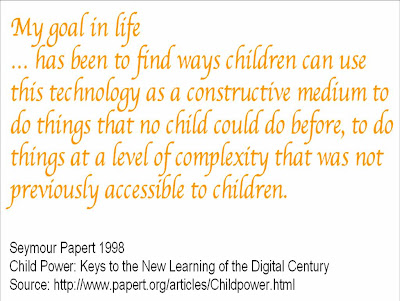Some key points:
(a) Building a Culture of Innovation
Innovation Transformation...
Automated >> Idiosyncratic (trivial use) >> At Scale (innovative practice) >> Cultural
- Beliefs & Attittude
- Opportunities & Possibilities:
- (i) Access to hardware (affordable computing)
- (ii) Pedagogy needs to be reinforced (in fact, this is neglected while PD usually & most of the time focuses on skills and forgotten about sound integration). We were once again reminded on the trivial use of technology in learning (which is very much back to the mp1 days - PowerPoint slides as high-tech transparencies; Interactive Whiteboards as high-class whiteboards!)
- (iii) Simple tools makes a difference when creatively used, not necessary complex tools
- (iv) Opportunities to let go some of the practices
- Pedagogical Wisdom
(b) Technology and Change
Innovation that will drive child-centredness...
- Increased interactivity & effectivenss of communciation (eg. the use of social networks like Facebook).
- Have educators re-look at what are the effective forms of communication and ways of communication for the digital natives?
- Have educators' way of teaching and use of technology address to the learners' diversity?
- Other considerations include learners' adaptability, individualised and personalised learning.
Promotes new dimensions of pedagogical innovation
- increase in shared visualisations and shared laboratory access
- increase in experiential learning
Look for more appropriate & effective means of assessment
- including embedded assessment
- more info about embedded assessment: Utah University; Blog write-up of faculty member of Socrates Technological University

Incremental Change vs Fundamental Change/Transformation
- Incremental change are small changes to the way school might function, it provides measureable improvements
- Fundamental change looks very different... it's not about tweaking
In fact, this reminded me of the actual situation in our schools! So often, schools have no choice, but to go through incremental change... and in fact, because of all the existing entities (staff, students, culture & practices... ), it's a great challenge to any leader who wants to carry out transformation! Think many of us would agree that Deep-seated Mindset is the most challenging of all... That's also why some of us think that we are fortunate enough to grow together with the school, from Day 1, start from scratch... of course, one has to treasure this hard-to-come-by opportunity to ensure all are set in the right direction!
Bruce then quoted...

Innovative Schools... cater to successful learning for rapidly changing environments
1. Learning Environment - Physical, Virtual, Formal/Informal, Innovative Use of ICT
- MET Center (Rhode Island) Official Website
- Hip Hop High School: Small is Big: Breaking down schools to break down barriers (note the design of the learning spaces)
2. Teaching, Learning & Assessment
- New Learning... New Literacies taking into account (i) classroom diversity (ii) differentiated and customised learning (iii) banks of learning content
- Lateral Communications: Peer-to-Peer, Learning as collaboration
- Collaborative Literacy (An interview with Dorothy Sisk: Collaborative Literacy)
3. Ongoing Professional Development
- Encourages Collaboration, hence, Peer Coaching on Collaboration

(c) Sustaining Innovation vs Disrutpive Innovation
- Disruptive Innovation by Clayton M. Christensen
- From Innovation Zen: The basic idea is that some innovations will appear as simpler, cheaper or even inferior solutions when compared to traditional technologies. In the early phase such innovations will serve a marginal or completely new market segment. Over the time, however, as the performance of the disruptive innovation improves (often faster than what is demanded by customers) it will be able address the mainstream market, displacing incumbents.
No comments:
Post a Comment